
table of contents
- Domestic butterflies
- From A to E.
- From F to J
- From K to R
- From S to V
- From W to Z
- frequently asked Questions
Butterflies are common in summer. But which moths actually fly around in Germany? We introduce you to local butterflies with a picture.
In a nutshell
- around 3700 butterfly species in Germany
- Habitat loss threat
- many species with individual characteristics
Domestic butterflies
Around 3700 butterflies are indigenous to Germany. However, more and more of these species are classified as endangered. The reason for this is above all
- pesticides used in agriculture
- Lack of forage plants
- Lack of open landscapes and rough meadows
- Destruction of biotopes and habitats
Despite the threat to the moths, there are still a large number of native butterflies. Among the best known are:
From A to E.
Admiral (Vanessa atalanta)
- Size: up to 65 mm
- Appearance: dark brown wings bordered by a red border; black wing tips with white markings
- Flight time: May to October
- Habitat: forest paths, forest edges, open meadows, pastures, orchards, embankments, parks, gardens, fallow land ...
- Diet: prefers flaming flowers (Phlox), butterfly lilacs (Buddleja davidii) or goldenrod (Solidago); also thistle (Carduus acanthoides), sun rose (Helianthemum), thyme (Thymus), water feast (Eupatorium), fallen fruit, beer

Apollo butterfly (Parnassius apollo)
- Size: up to 88 mm
- Appearance: white wings with white nucleated red eye-spots on the hind wings; black cube spots on forewings; glassy outer wing edges
- Flight time: July to August
- Habitat: Warm, flower-rich slopes, hills, steep cliffs, brick slopes, stone and rocky slopes
- Food: Thistle, knapweed (Centaurea), real dost (Origanum vulgare), white sedum (Sedum album), large sedum (Hylotelephium telephium)

Aurora butterfly (Anthocharis cardamines)
- Size: up to 45 mm
- Appearance: whitish wings with black spot; white-green patterned wing undersides; Males also have orange wing tips
- Flight time: April to June
- Habitat: Trees, clearings, forests, wet grassland, parks and gardens
- Food: preferably meadowfoam (Cardamine pratensis) and garlic rocket (Alliaria petiolata); also: bitter foam herb (Cardamine amara), night violet (Hesperis matronalis), mountain pea (Lathyrus linifolius), vetch (Vicia sepium), chickweed (Stellaria holostea), red carnation (Silene dioica), Hawthorn (Crataegus)
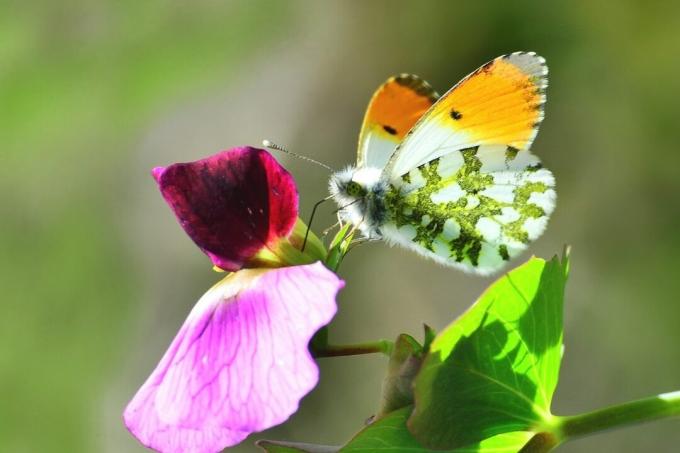
Tree whiteling (Aporia crataegi)
- Size: up to 80 mm
- Appearance: white. Slightly transparent wings; Males with black wing veins and black spot on forewings; Females have brown veins without a spot
- Flight time: May to July
- Habitat: open and cultivated land; Embankments, orchards, hedges, forest edges, grasslands, gardens
- Food: Thistles, alfalfa (Medicago sativa), adder's head (Echium vulgare), meadow sage (Salvia pratensis), red meadow clover (Trifolium pratense), red dogwood (Cornus sanguinea)

C-folder (Polygonia c-album)
- Size: up to 50 mm
- Appearance: orange-black to yellow-brown patterned; white "C" on the underside of the hind wings
- Flight time: June to May
- Habitat: damp locations, forests, roadsides, aisles, clearings, orchards, wood-rich areas in open land
- Diet: Common willow (Salix caprea), blackthorn (Prunus spinosa), buddleia, species of thistle and dost
- other: good and quite frequent pollinator of berry bushes

Note: There is a myth that C-butterflies suck up berries. But that's wrong. They only suck on windfalls.
Painted Lady (Vanessa Cardui)
- Size: up to 60 mm
- Appearance: orange with black pattern; white dots on the outer edges; Hind wings marbled brown and white
- Flight time: April to October
- Habitat: open land, dry wasteland, fallow land, juniper heaths, dirt roads, fields, meadows, settlement areas, avoid forests
- Food: thistles, knapweed, straw flower (Helichrysum arenarium), scabious (Knautia), mallow (Malva) ...
- other: beneficial insect, pollinates thistles

Oak processionary moth (Thaumetopoea processionea)
- Size: up to 36 mm
- Appearance: ash- to brown-gray wings with serrated markings; gray-white, darkly fringed hind wings
- Flight time: July to September
- Habitat: preferably oak trees, also hornbeam; occasionally on roadsides and in parks
- Food: moths do not eat; Caterpillars eat leaves of the host tree
Note: The hair of the caterpillar of the oak processionary moth can be fierce year-round allergic reactions trigger. The moth, on the other hand, does not pose a health risk.
From F to J
Blue Buckthorn (Celastrina argiolus)
- Size: up to 30 mm
- Appearance: pastel blue wings; females wide black wing wheels; Males thin black impellers; Ice-blue to white-gray underside of the wing with small black spots
- Flight time: April to September
- Habitat: forest fringes and meadows rich in bushes, pastures, clearings, riparian zones, fallow land and urban areas
- Food: blackberry (Rubus spec.), Purple loosestrife (Lythrum salicaria), dost, buckthorn (Frangula anus), Heather (Erica spec.), Alfalfa, animal excrement, honeydew
- other: enters into symbiosis with ants
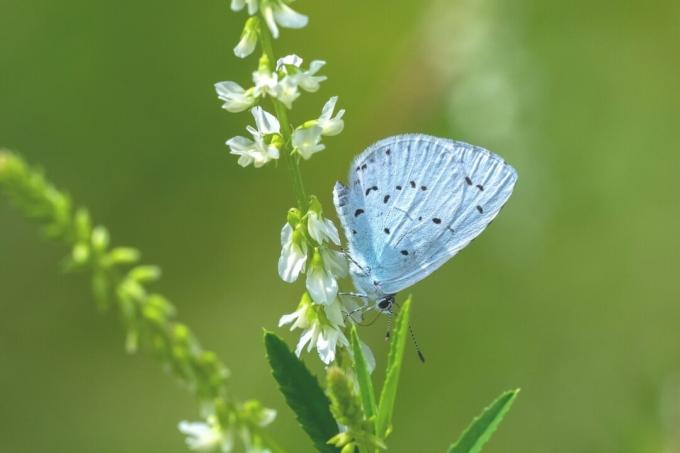
Gamma owl (Autographa gamma)
- Size: up to 40 mm
- Appearance: gray to brown; characteristic drawing on forewings
- Flight time: February to December
- Habitat: no special habitat; avoid closed forests
- Food: blossoms, trees and bushes of all kinds, also fields with cabbage (Brassica), lettuce (Lactuca sativa) and spinach (Spinacia oleracea)
- other: one of the most common moths, hummingbird-like soaring flight, serious feeding damage possible with mass reproduction

Great Kingfisher (Limenites populi)
- Size: up to 90 mm
- Appearance: dark blue with white spots; Broad white banded females surrounded by orange and blue banded edges; Males without a white band; Underside of wing orange with black and white spots; blue-gray edges
- Flight time: June and July
- Habitat: Forest fringes, especially crown area, military training areas, abandoned gravel pits
- Food: no nectar plants; Suck on roadsides, puddles, dew, carrion, animal excrement, honeydew, tree sap
- other: dependent on cold winters
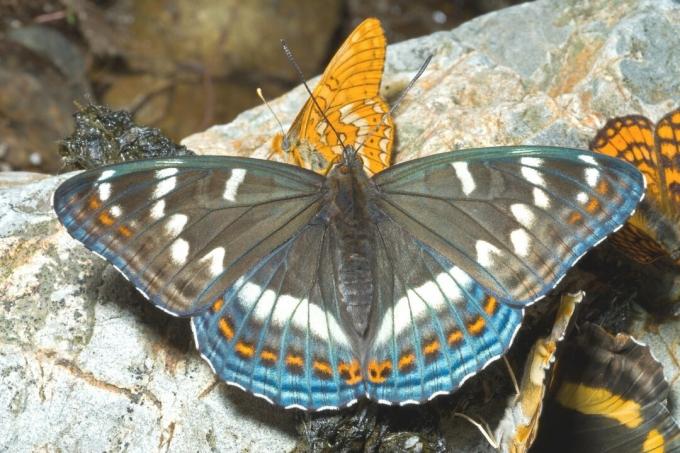
Great Fire Butterfly (Lycaena dispar)
- Size: up to 40 mm
- Appearance: orange wings; Males with black, white frayed wing edge; Females dark brown to orange-red, wing edges frayed white
- Flight time: June to September
- Habitat: Moist locations, wet meadows, ditches and riversides, fens, fallow meadows, road embankments, cattle pastures
- Food: flowering plants such as water dost, purple loosestrife, ground elder (Aegopodium podagraria), valerian (Valeriana), water mint (Mentha aquatica), yarrow (Achillea), cornflower (Centaurea cyanus)
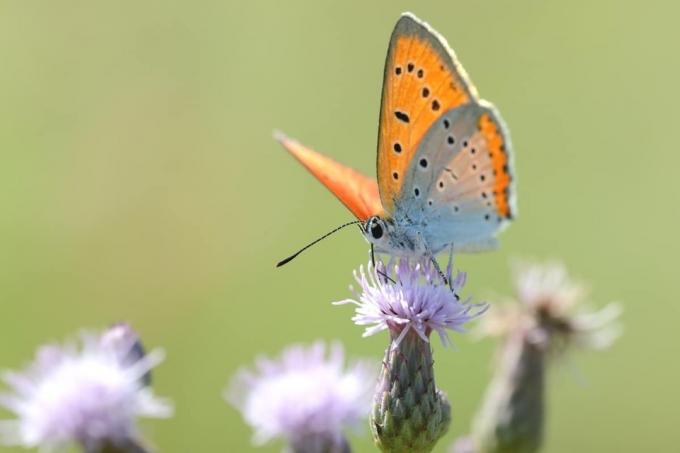
Big fox (Nymphalis polychloros)
- Size: up to 55 mm
- Appearance: orange-red wings with black-white-yellow pattern; Hind wing margin pale blue colored
- Flying time: late June to May
- Habitat: light forests, forest edges, parks, gardens, orchards, dry grass with bushes
- Food: rarely on nectar flowers; rather tree sap, windfalls, animal excrement, carrion
- other: one of the largest native butterflies, but rare

Great Cabbage White (Pieris brassicae)
- Size: up to 60 mm
- Appearance: white wings with dark gray tips; Females two black spots on the forewings; Hind wings white with grayish spots on the edge; Underside white to grayish in color
- Flight time: April to October
- Habitat: coastal regions and open land; Settlement area, rapeseed fields, agriculturally used ruderal areas, forests, meadows
- Food: thistles, real medicinal valerian (Valeriana officinalis), Carthusian carnation (Dianthus carthusianorum), Clover (Trifolium spec.), Alfalfa, butterfly lilac, meadow foam herb
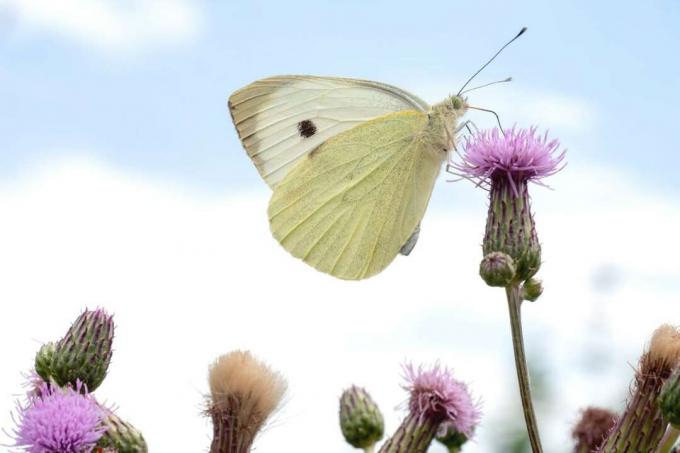
Note: The large cabbage white butterfly owes its name to its caterpillars. They prefer to feed on various types of cabbage.
Great ox-eye (Maniola jurtina)
- Habitat: dry to moist locations, grassland, excessively used grassland, forest roads, railway embankments, set-aside areas, post-mining landscapes, settlement areas
- Flight time: June to September
- Size: up to 48 mm
- Appearance: Males: dark brown upper side of the wing, dark scented flakes near the base, wing tips m orange rimmed, white pithed, black eye spots, female dark brown, orange spot in the middle of the wing, bigger eye
- Food: thistle species, widow flowers, knapweeds, dost, marigolds (Calendula officinalis), yarrow, mountain sand bells (Jasione montana), blackberry, clover species, tansy (Tanacetum vulgare), devil sabbis (Succia pratensis), pigeon scabiosa (Scabiosa columbaria)

Blue grouse (Polyommatus icarus)
- Size: up to 30 mm
- Appearance: males intense blue; Females brown with a bluish cast; Wings with light border; light underside of the wing with black and orange dots
- Flight time: May to October
- Habitat: open land; Lean grasslands, embankments, roadsides, dry grasslands, post-mining landscapes, ruderal corridors
- Food: common horn clover (Lotus corniculatus), meadow pea (Lathyrus pratensis), dost, thyme, wound clover (Anthyllis vulneraria), hop alfalfa (Medicago lupulina)

From K to R
Imperial coat (Argynnis paphia)
- Size: up to 65 mm
- Appearance: brown-orange with rows of black dots parallel to the wing edges; Males with striped scented scales; Greenish white underside with silver
- Flight time: July to September
- Habitat: near-natural forests, forest edges, gardens, bushes, forest bog meadows, dry slopes with bushes, abandoned gravel pits, settlement area
- Food: Thistles, Dost, blackberries, buddleia, linden (Tilia), privet (Ligustrum), ragwort (Senecio vulgaris)

Little Fire Butterfly (Lycaena phlaeas)
- Size: up to 27 mm
- Appearance: orange-red, lightly fringed wings with dark brown wing edges and several dark cube spots; Hind wings dark brown with an orange band on the margin; Underside faintly spotted
- Flight time: May to October
- Habitat: (semi) dry grassland, ruderal areas, fallow land, embankments, roadsides and paths, heaths, embankments, residential areas
- Food: heather, mountain aster (Aster amellus), Bell heather (Erica tetralix), Tansy, horse mint (Mentha longifolia), Pigeon scabiosa, water feast, daisy (Leucanthemum vulgare), Thyme

Note: (Small) fire butterflies are after § 1 Annex 1 of the Federal Species Protection Ordinance specially protected. on the red list of endangered species however, they do not stand.
Little fox (Aglais urticae)
- Size: up to 50 mm
- Appearance: orange wings with dark brown wings and black-yellow-white pattern; cyan dots surrounded by black at the edge
- Flight time: May to October
- Habitat: open land biotopes, forest edges, gardens, paths, parks, inland dunes, ruderal areas
- Diet: butterfly lilacs, dahlias (Dhalia spec.), Asters (Aster spec.), Water dost, alfalfa, thistles, dandelion (Taraxacum), red meadow clover, meadow knapweed (Centaurea jacea)
- other: one of the most famous native butterflies; pollinates more than 200 different nectar plants

Little Schiller Butterfly (Apatura ilia)
- Size: up to 60 mm
- Appearance: dark brown wings with a band of white spots; Males with blue shimmering structural color; black-orange rimmed eye spots on fore and hind wings
- Flight time: June and July
- Habitat: Forests, roadsides with deciduous trees, abandoned gravel pits
- Food: no sources of nectar; sucking on moist soil, carrion, animal excrement, honeydew, tree sap, fermented gooseberries (Ribes uva-crispa) or plums (Prunus domestica)

Little meadow bird (Coenonympha pamphilus)
- Size: up to 33 mm
- Appearance: brown-ocher-colored wings with a gray edge; brightly rimmed eye spot with white spot in the middle of the wing tips; white to gray underwings with a light transverse band
- Flight time: April to November
- Habitat: open grass areas, meadows, pastures, embankments, ruderal areas, path and field edges, sand and gravel pits
- Food: Wild plants such as buttercups (Ranunculus) or margarites, yarrow, clover (Medicago spec.), Meadow knapweed, common purple loosestrife, tansy, water stew, field thyme (Thymus pulegioides)
- other: most common meadow bird species
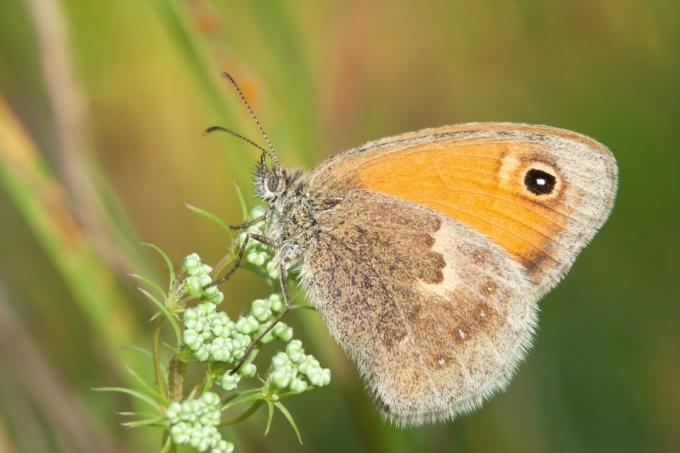
Land map (Araschnia levana)
- Size: up to 43 mm
- Appearance: either orange-brown spring generation with black spots and a white border or dark summer generation with cream-colored band and white spots on forewings
- Flight time: April to August
- Habitat: Forests, forest edges, parks, aisles and the edges of settlements
- Diet: Water dost, rosemary heather (Andromeda polifolia), swamp porst (Rhododendron tomentosum), wild carrot (Daucus carota subsp. Carota), yarrow, valerian, blackberry, thistle

Plum Hairstreak (Satyrium prunis)
- Size: up to 28 mm
- Appearance: dark gray-brown wings with orange band on wing edges;; Wing underside gray-brown with white line and orange band with black dots; protruding "tip" at the end of the wing
- Flight time: May to July
- Habitat: warm, sheltered places; Plum trees, sloe bushes
- Diet: Common privet (Ligustrum vulgare), elderberry (Sambucus), blackberries

From S to V
Chessboard (Melanargia galathea)
- Size: up to 52 mm
- Appearance: checkered black and white pattern or dark brown spots; Underside white to light brownish
- Flight time: June to August
- Habitat: Rough lawns, dwarf shrub heaths, roadsides, forest aisles, embankments, orchards, overgrown orchards
- Food: prefers nutrient-poor flowering meadows and lavender to violet flowers; Real dost, meadow knapweed, meadow clover, field scabious (Knautia arvensis), thistles, scabies
- other: Butterfly of the year 2019

Dovetail (Papilio machaon)
- Size: up to 80 mm
- Appearance: yellow wings with black pattern; black hind wing processes; Inner margins with a small, round, red spot
- Flight time: April to September
- Habitat: sunny, open terrain; Rough lawns, gardens with carrots, dill and fennel
- Diet: prefers purple flowers; Red meadow clover, buddleia, knapweed, thistles, dost, lavender (Lavandula angustifolia) field scabious, alfalfa, Carthusian carnation (Dianthus carthusianorum)
- other: one of the largest native butterflies

Six-spot ram (Zygaena filipendulae)
- Size: up to 38 mm
- Appearance: six red spots on shiny silvery forewings; red hind wings
- Flying time: May to September
- Habitat: Meadows, lowlands, cliffs, fallow land, forest edges, dry grassland, ruderal sites, gravel pits
- Food: Meadow knapweed, scabious flowers, pigeon scabies, carnations (Dianthus), flat peas, bluebells (Campanula), St. John's wort (Hypericum perforatum)

Sail butterfly (Iphiclides podalirius)
- Size: up to 80 mm
- Appearance: light yellow wings with dark bands of different sizes; three blue eye-spots on hind wings with light ends
- Flight time: April to June
- Habitat: very warm; hot slopes, scrubland post-mining landscapes, energy routes, heathland areas, mild river areas, settlement areas with orchards
- Food: plum, elder, rapeseed (Brassica napus), privet, meadow sage (Salvia pratensis), buddleia, adder's head

Peacock butterfly (Inachis io)
- Size: up to 55 mm
- Appearance: four blue-black-yellow eye spots on the tops of each wing tip; Eyes on the hind wing with blue markings; brown hem along the slightly serrated wings; black marbled wing undersides
- Flight time: July to May
- Habitat: open land to forest; flower-filled forest clearings, settlement areas, gardens and parks
- Food: broad spectrum, predominantly violet flowers: thistles, buddleia, sedum plant, water feast, Wild teasel (Dipsacus fullonum), blackberry, alfalfa, heather, sloe, dandelion, Meadow foam herb
- other: One of the most common native butterflies
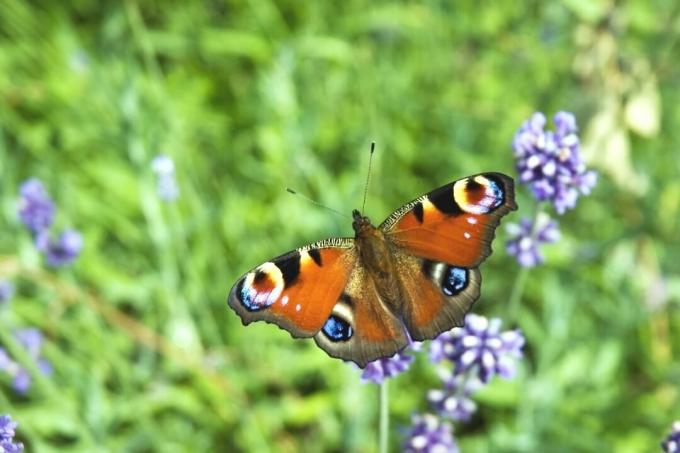
Note: The peacock's large eyes serve as a defense strategy. They are supposed to intimidate enemies and thus keep them away.
Pigeon tail (Macroglossum stellatarum)
- Size: up to 55 mm
- Appearance: large, stocky body with a three centimeter long trunk; gray-brown wings with dark coloring on the abdomen; white tufts of hair on the sides; Underside light gray and brown-orange
- Flight time: August to May
- Habitat: open land, dry grassland, meadows, in residential areas in parks and gardens
- Food: clover, adder's head, primrose (Primula), snail clover (Medicago), cranesbills (Geranium), violets (Viola), cysts (Stachys)
- other: hovering in front of a flower

Mourning gown (Nymphalis antiopa)
- Size: up to 75 mm
- Appearance: dark brown with white / pale yellow slightly frayed wing edges; Inward wing hem with blue and black rimmed spots
- Flight time: mid-July to mid-June
- Habitat: Forests, forest edges, heathland areas in military training areas, forest paths, orchards, gardens
- Diet: rarely nectar flowers; sucks tree sap and windfalls, willow blossoms, leaking tree sap
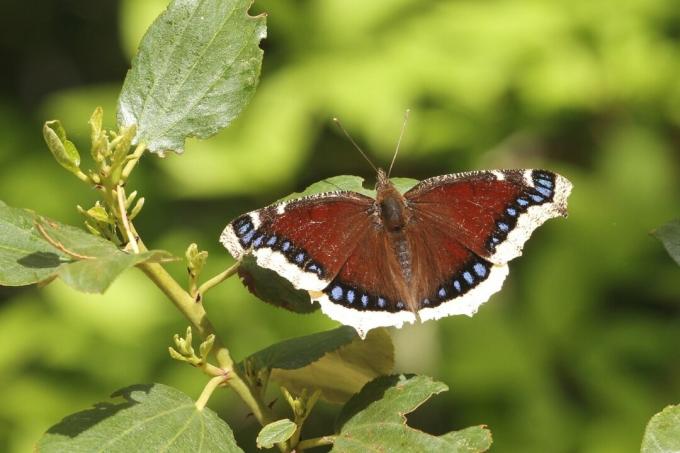
From W to Z
Forest board game (Pararge aegeria)
- Size: up to 45 mm
- Appearance: dark brown wings with light yellow and black, white nucleated spots; three to four dark eye-spots on the hind wings; interrupted white narrow wing hem; Ocher-colored underside with white spots, eyes and marbling
- Flight time: April to August
- Habitat: damp to slightly dry forests, orchards, parks and gardens
- Diet: rarely nectar flowers; sucks damp earthen spots, tree wounds, honeydew, ripe fruits

Wandergelbling (Colias croceus)
- Size: up to 50 mm
- Appearance: Males have orange-yellow wings with a broad, dark band at the edge; Females with yellow spots in a dark band at the edge; Underside with dark spots
- Flight time: April to
- Habitat: open land
- Food: meadow clover, seed alfalfa (Medicago sativa), meadow knapweed

Brimstone butterfly (Gonepteryx rhamni)
- Size: up to 55 mm
- Appearance: lemon-yellow to pale greenish-white wings, pointed wing tips, orange spot on the top, brown spot on the underside
- Flight time: mid-July to June
- Habitat: any open area
- Food: prefers red-violet flowers; Meadow knapweed, meadow clover, daphne family (Thymelaeaceae), lark spur (Corydalis), lungwort (Pulmonaria officinalis), species of thistle
- other: summer and winter rest; can be 10 months old as the only native butterfly
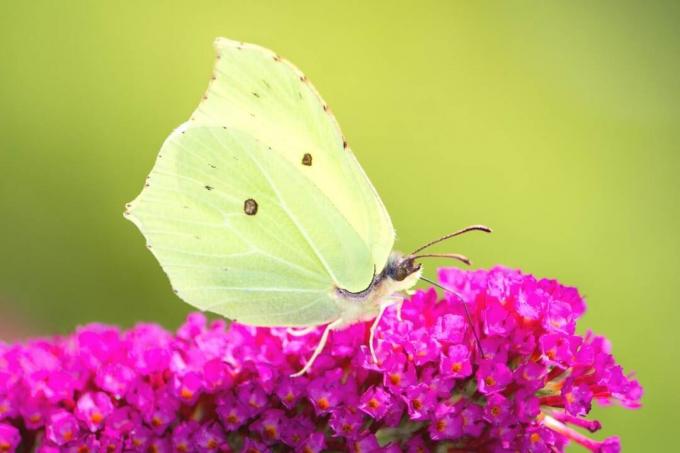
Note: Brimstone butterflies can excrete a large part of their body fluids in winter and then fall into hibernation. So they withstand temperatures down to - 20 ° Celcius.
frequently asked Questions
Not necessarily. Environmental conditions such as temperature can lead to the formation of special shapes and colors of some types of butterflies. These moths then look different than described.
Plant a variety of flowers and trees in your garden. In this way you create food sources and a habitat for the flying insects.
It depends on the species. Some butterflies can tolerate the cold and therefore overwinter as butterflies in attics or in basements. Other species are less resistant to cold and therefore move to warmer areas in winter. Still others die before the cold season, so that only the new generation hibernates as pupated caterpillars.
